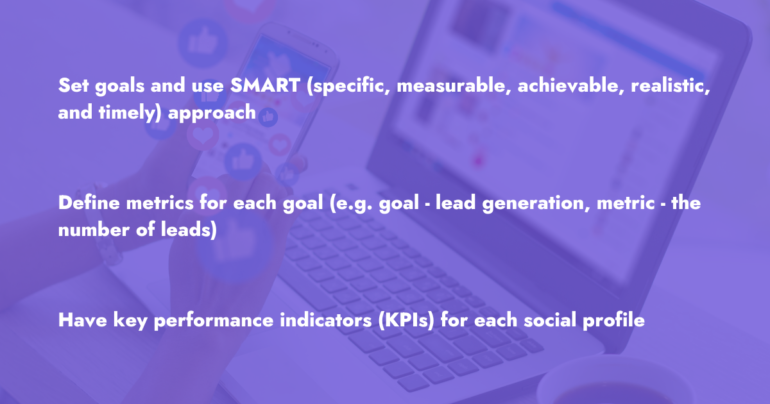How many hours do you spend on the Internet? A lot, right? For instance, smartphone users spend approximately 4 and a half an hour on social media in Dubai, and the average time spent on social media worldwide is 2 hours and 27 minutes.
After knowing this number, do you feel how essential it is to have a successful social media strategy for your business to help users know about your services and products? Yes, we know that you do.
But how can you have a successful strategy? Let’s take a look at the most crucial 6 steps for your social media marketing strategy success.
1. Content Calendar
One of the most important things you can do to set up your promotional strategy is to have a social media calendar. This will help you plan out all of your posts, allowing you to make sure that they’re posted on time and that they’re all consistent in tone of voice. Follow these steps for better results:
- Make sure you have an easy-to-use tool that works well with your schedule and your goals.
- Set realistic expectations for what you can accomplish in one day, week, or month — don’t try to do too much.
- Know who is responsible for each task and set deadlines.
- Find which are the best times to post on social media platforms.
- It’s all about consistency — your audience likes the same thing over and over again, so changing your brand’s tone or style constantly will make your brand seem unreliable.
- Make sure your social media calendar includes holidays, and birthdays (of both your employees and clients), as well as anything else that might be important for planning purposes (like conferences).
As a bonus, you can fill out your email and get a social media marketing calendar template for free.
2. Social Media Audit
Conducting a social media audit will give you an idea of where your brand is currently at, and what it needs to focus on. For example, if you find that your content isn’t engaging with followers but they’re liking it anyway, then maybe it’s time to change things up.
Review the results your social media marketers achieved over the last year with their social media endeavours. By doing so, you may evaluate each channel’s effectiveness and performance, as well as understand what works well and decide what you can do to improve your performance.

If you want to conduct an audit, here are some things to pay attention to:
- Check all your company’s social media accounts (Facebook page and Instagram account) and see how active they are.
- Review the analytics for each platform (number of followers/likes/comments). You can also check their reach by looking at the engagement rate (engagement divided by follower count) or post views compared with likes and comments. Check each piece of content (text posts, images) posted on these platforms. Look at the audience demographics — are they mostly men or women? Do they come from Dubai or another city in UAE? Are they foreigners? Are these followers mostly engaged with this type of content?
- Research your competitors to see what they do better than you.
Digi-Tip: Determine what works for your audience by analyzing the posts with the greatest and poorest results.
3. Hashtags and Keywords
Hashtags are phrases or words preceded by the hash symbol (#), that are used to organize posts on social media, and help people find and follow your brand.
To attract new followers, you need to use hashtags that are relevant to your business and industry. You may also want to consider using hashtags for specific events or campaigns related to your business. Use hashtags that can be easily found when users search for them. Follow these steps for better results:
- Find influencers on social media within your brand’s niche and see what kind of hashtags they use and how many times.
- Research competitors and see what kind of hashtags they use for their posts.
- You can find which hashtags are popular and good to use by checking the tools Ritetag and Hashtagify.me.
- Analyze your best-performing posts to see what kind of hashtags you used.
4. Paid Ads
If you want to boost engagement and make more people know about your services, you need to consider paid ads. With the help of social media advertising, you can promote your brand and products. And the more people see your posts, the more opportunities your brand will have to engage with them.

For example, if you’re hosting an event and want it to attract attendees from different locations in Dubai (or outside), targeted advertising will help ensure that all potential guests know about it while they’re online. You’ll be able to reach every person who is interested in attending this event — through social media networks like Facebook or Instagram.
Digi-Tip: Use Google Ad’s keyword targeting feature on websites like Trip Advisor, where prospects may look for details about upcoming events in Dubai.
5. Cross-promote Content
Before choosing any platform, ask yourself: Which platform is right for my business? Which platform is suitable for my target audience? Which platform is working with my budget? These can help narrow down your options and point you toward the best fit.
Once you’ve decided where to start investing your time and resources into building a social media presence, it’s time to create posts and cross-promote them.

When you cross-promote content, you’re distributing the same message across multiple social media channels. This strategy helps to reach a wider audience because it allows users to interact with the same post on different platforms. For example, if your organization has a blog post about how to properly cook salmon fish, then it makes sense for your team members to share that same piece of writing on Twitter and Facebook at the same time.
6. Track and Analyze Your Social Media Results, Then Repeat
You should always set goals and key performance indicators (KPIs) for analyzing how your actions met them.

If you achieved your goals, the next essential step for your social media plan is setting up Google Analytics. It’s crucial in building a successful social media strategy for each of your social accounts and platforms.
With Analytics, you can measure the following:
- Reach — How many people saw your content?
- Retention — the percentage of users who return after visiting the first time.
- Engagement — How many people interact with your content? The percentage of users who like, comment or share a post.
- What platform works best for you at different times of day and on different days of the week/month?
- Conversion — how many people take action after seeing your post?
We hope this social media marketing checklist has given you some ideas about how to create an effective social media strategy for your business. Having trouble managing social media marketing? Let Digilite’s experienced SMM specialists handle it for you! Contact us today!




